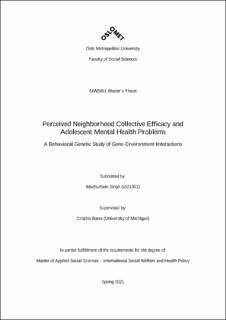Perceived Neighborhood Collective Efficacy and Adolescent Mental Health Problems: A Behavioral Genetic Study of Gene-Environment Interactions
Master thesis
Published version
Permanent lenke
https://hdl.handle.net/11250/2789592Utgivelsesdato
2021Metadata
Vis full innførselSamlinger
Sammendrag
Background: Perceived neighborhood collective efficacy is known to buffer the impact of diverse social-environmental risk factors on adolescent mental health problems. However, it is unknown whether collective efficacy also moderates individual genetic propensity for these disorders.
Objectives: To examine whether perceived neighborhood collective efficacy moderates the genetic influences on adolescent internalizing and externalizing problems and smoking initiation and assess whether these G×E interactions differ across sex.
Design: Quantitative behavioral genetic study design examining twin pairs stratified by zygosity and sex. Structural equation modeling was used to estimate latent genetic and environmental sources of variance in the three traits and the sex-specific moderation of these variance parameters by perceived neighborhood collective efficacy.
Setting: In-home structured interviews of adolescents recruited from a stratified random sample of high schools and middle schools in the U.S.
Participants: A nationally representative sample of 762 twin pairs (282 monozygotic and 480 dizygotic), aged 12–19 years (mean 16.0, S.D. 1.60).
Main outcome measures: Symptom-based scales of internalizing (depressive and anxiety) and externalizing (rule-breaking and aggressive) problems, and a binary measure of having ever smoked a cigarette.
Results: Perceived neighborhood collective efficacy moderated the genetic influences on internalizing symptoms only, and these G×E interactions followed distinct patterns in females and males. There was no evidence for G×E interactions in externalizing and smoking initiation.
Conclusion: High levels of perceived neighborhood collective efficacy attenuated the genetic influences on internalizing symptoms in females, following the diathesis-stress model. In males, the genetic influences were negligible at intermediate levels of perceived neighborhood collective efficacy but increased at both high and low levels of the latter, suggesting a differential-susceptibility process. These G×E findings help integrate bioecological perspectives in the collective efficacy theory, which may aid in developing more robustly informed community interventions for youth mental health.
